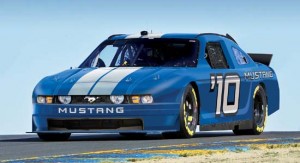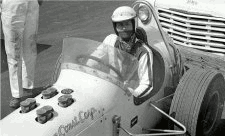Author Archive
Philippe, Power Injured at Sonoma
Posted by: | CommentsNelson Philippe and Will Power were hospitalized after a practice crash at Infineon Raceway in Sonoma, CA today, according to a statement issued by the IndyCar Racing Series. A third driver, EJ Viso, was also involved in the incident but was uninjured.
Both drivers suffered concussions with Power breaking two veterbra in his back. Philippe underwent surgery for a broken left foot.
The report says that Philippe lost control exiting turn 3 on the road course and then was struck by Viso's car and then finally by Power.
Racing Replay: 1988 Budweiser at the Glen
Posted by: | CommentsI love watching the old Winston Cup cars being slung around the road courses as the drivers work the gears. Here's the final restart of the 1988 Budweiser at the Glen at super-fast Watkins Glen International. Darrell Waltrip is leading Ricky Rudd, Mike Alexander and Bill Elliott. But the man on the move is Rusty Wallace!
I also have to give a shout out to that super-hot Ford Thunderbird pace car. ![]()
Near the end is a look at Rick Wilson's stock car career in a nutshell.
Calling the race for ESPN are Bob Jenkins -- who has a propensity for getting worked up it seems -- and Ned Jarrett.
Mustang to Make NASCAR Debut in 2010
Posted by: | CommentsFord Motorsports announced Tuesday that its Mustang model will make its NASCAR debut in 2010. It'll be the first time the Mustang brand has competed in NASCAR and the first Ford coupe in the Nationwide Series since the 1997 Thunderbird. The new Mustang will be coordinated with NASCAR's transition of the Nationwide Series' cars to the "Car of Tomorrow" platform. The platform will be nearly identical to that currently used in the Sprint Cup division, however the plan is to use different body styles in the Nationwide Series.
 Image of 2010 NASCAR Nationwide Series Ford Mustang, courtesy Ford Motorsports.
Image of 2010 NASCAR Nationwide Series Ford Mustang, courtesy Ford Motorsports.
NASCAR expects to phase in the new car over 5 or 6 races in the 2010 season before employing the car full-time in 2011. The Chevrolet, Dodge and Toyota manufacturers have not officially announced which model they intend to submit for the new car design, however Dodge is rumored to propose its Challenger brand for 2010. NASCAR is interested in differentiating body styles from its highly-criticized Sprint Cup COT. According to a release made available from NASCAR.com, the new Nationwide car will sport a rear spoiler (rather than a wing) and a spring front suspension (rather than bump stops). The front splitter will apparently carry over from the Sprint Cup COT.
Ford Motorsports claims the Mustang has accumulated over 2,000 professional race victories. The fifth-generation Ford Mustang has enjoyed success in the KONI Challenge, SCCA Speed World Challenge and Formula Drift events. Ford has competed in the NASCAR Nationwide Series since its inception in 1982 under various brand names: Fairmont (1982-1986), Mercury Cougar (1984), Thunderbird (1987-1997), Taurus (1998-2005), and Fusion (2006-Present).
Click here to read the press release from Ford Racing.
Here's my take on it: I think this is a great step in the right direction for NASCAR and the car manufacturers. It seems that NASCAR is taking a conservative approach with the new car's debut; I think they could have been more aggressive though. While it's certainly an improvement over the Sprint Cup COT -- "let's just put headlight decals on the thing and pretend it's a stock car" -- they could have gone a little further and allowed a more stock body and -- dare I say -- allowed the various makes to have different downforce numbers.
Why not take the guts of the COT platform (e.g., the frame, etc.) and throw a fully stock body on top of it? Drop in a front valence and rear spoiler for safety and then let them drive it. No headlight decals allowed. Whoever builds the better car wins. And it would be great to have something that handles dramatically different than the Sprint Cup cars to throw those drivers for a loop. Let the manufacturers duke it out for a little added drama.
We'll see how it goes. It has to be better than the Fusion.
Alabama to Host Indy Racing in 2010
Posted by: | CommentsThe Barber Motorsports Park in Birmingham, AL announced today that the Indy Racing League has signed a three-year deal to bring Indy car racing to the Alabama track. The inaugural "Indy Grand Prix of Alabama" is scheduled for the April 9-11 weekend of 2010.
The Indy Racing League held a practice session on the 2.38-mile road course in March 2009. At 45 feet, the track is slightly wider than Watkins Glen International. Officials are hoping to draw 100,000 spectators over the three-day weekend.
The Barber Motorsports Park is located about 50 miles west of Talladega Superspeedway, where NASCAR typically races on the last weekend of April.
Happy Harvick Not So Happy?
Posted by: | CommentsTim Tuttle at SI.com, citing "multiple sources", is reporting that Kevin Harvick is asking out of his contract with Richard Childress Racing (RCR) after this season. Harvick has another year remaining on the contract, but according to the report he is looking to move over to Stewart-Haas Racing, perhaps taking sponsor Shell/Pennzoil with him.
RCR has had a poor season so far in 2009 and Harvick is mired back in 25th in the point standings, pretty much putting him out of contention for the championship. Meanwhile Tony Stewart has had a remarkable season with his new team, posting fifteen Top-10s and two wins. Stewart leads the driver standings by 175 points over Jeff Gordon. The NASCAR Sprint Cup season passed the halfway point after Sunday's race at Chicagoland.
Harvick stepped into the RCR #29 team after Dale Earnhardt was fatally injured at Daytona in 2001. The team changed numbers from 3 to 29 out of respect for Earnhardt. In just his third start for the team, Harvick posted his first win in a photo finish at the Atlanta race in March.
Harvick has not won a Sprint Cup race since the 2007 Daytona 500.
Racing Replay: 1988 Pepsi Firecracker 400
Posted by: | CommentsThe 1988 Pepsi Firecracker 400 at Daytona Int'l Speedway had Bill Elliott starting all the way back in 38th place. But on the last lap he held off a hard charge from Rick Wilson to take the win by just a couple of feet as Phil Parsons, Dale Earnhardt and pole-winner Darrell Waltrip battled for third place.
This video is from the live satellite feed. ABC was scheduled to broadcast the race on a tape delay. After the race finish there is an interim period where Paul Page and his fellow commentator (sorry, don't know who it is) attempt to record the replay coverage. That is followed by post-race interviews with Elliott and Wilson. Elliott earned $63,500 for the win.
The 1988 running was the first time that the Firecracker 400 was not run on July 4. Beginning this year it was moved to the first Saturday in July -- July 2 in this case. Since then, the race has only run on July 4 one other time -- in 1992. It was scheduled to run on July 4 in 1998 (the first night race), but that event was postponed to October due to wildfires. The race will be run this year on July 4, the first time since 1992.
Incidentally, 1988 was the last time the "Firecracker" name appeared in the race title. Beginning in 1989 the race became known as the Pepsi 400.
Should NASCAR Races Be Shortened?
Posted by: | CommentsI was reading Ernie Saxton's column at phillyBurbs.com and he brought up some good points about how the current length of NASCAR Cup races could be detrimental to fan interest. The topic of shortening races has been brought up in the past and, in fact, Rockingham and Dover had both trimmed their 500-mile races by a hundred miles in the mid- and late-1990s.
Why 500 Miles?
Somehow or another NASCAR eventually evolved into featuring primarily 500-mile race distances, or something similar (such as 500 laps at Bristol). Like running, motorsports has a diversity of race lengths aimed to test different strengths. For example, a 400-meter sprint emphasizes the runners' power (strength and speed). The most analogous form of motorsports to a 400m sprint would be what we typically see at our local short track. A marathon run, on the other hand, tests the runners' endurance -- like auto racing's 12 Hours of Sebring. A NASCAR 500-miler is more like a 5K run -- requiring a mix of both speed and endurance.
In other words, it appears that NASCAR wanted the element of attrition to be a factor in its races. It's not enough to be fast... the driver has to be fast over a long haul.
In previous decades, attrition was a major player in NASCAR races. Five-hundred laps at a place like Bristol must have been hell without power steering. And 500 miles at Talladega before restrictor plates was probably just as hellish on engines. But in today's NASCAR, attrition isn't quite the element it used to be. Mechanical failures are not nearly as common as they were years ago, and driver fatigue is almost unheard of. About the only thing that doesn't last anymore are Goodyear's tires.
Without attrition, is it really important to run 500 miles anymore?
Shorter Races = More Excitement?
So will shorter races be more exciting races? I remember when Dover trimmed its race distances from 500 miles down to 400. For the most part, everyone was on board with that move. (Though many ticket holders wondered if the prices would be trimmed by a fifth as well. They weren't.) So... is Dover any more exciting now that it's 400 miles? Well... I think it's safe to say that there's 100 laps less of boredom, so maybe that could count for something. I mean -- the pain is over quicker, so yes in that sense it's better.
And the Cup series does have a handful of 300-mile races (Phoenix, Loudon). I'm not sure that they're any more popular than the others. Of course the Nationwide series regularly runs 200- and 300-mile races (and with all the Sprint Cup drivers to boot), and there isn't a lot of viewing interest. Likewise, the Indy cars run 200-mile races and... well... we don't even have to go there.
What's the Primary Problem?
NASCAR needs to understand that "race excitement" isn't sufficient for their product. They need to re-generate excitement for their entire Series -- "the big picture". They could have a 50-lap race with a thousand passes and it won't cut the mustard if people aren't interested in the drivers and the drama of the circuit.
Most fans don't tune in just to see passes and crashes. I remember watching four-hour races on television every week just to see if Davey Allison could hold on to the point lead... or to see who Dale Earnhardt was going to wreck next... or to see if Rusty Wallace really would retaliate for being taken out at Bristol.
Between vanilla drivers, cookie-cutter tracks and the "Race for the Chase" format, NASCAR has pretty much flushed those concepts down the toilet and taken much of the fans' interest down with it.
At this point, does it really matter how long the races are?
Tidbits to Ponder
Here are some interesting facts from Fox Sports (via Jayski.com):
- After Dover, Cup races were averaging a caution period every 40 miles of racing. In 2008 the average was one every 45 miles. In 2001, one every 63 miles. In 1999, one every 72 miles.
- Through Dover, Cup race speeds had averaged 118 mph. In 2008, race speeds averaged 124 mph. In 2001, 128 mph. And in 1999, 130 mph.

